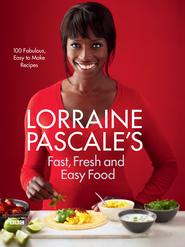По всем вопросам обращайтесь на: info@litportal.ru
(©) 2003-2024.
✖
Home Cooking Made Easy
Настройки чтения
Размер шрифта
Высота строк
Поля
Put the trays in the fridge for 15–20 minutes to firm up, or in the freezer for 10 minutes. Preheat the oven to 220°C (425°F), Gas Mark 7. Remove the twisties from the fridge and brush the pastry with the eggwash. Put the baking trays into the oven, turn the oven down to 200°C (400°F), Gas Mark 6 and cook for about 20 minutes, or until the pastry is well risen and looks golden brown. Preheating the oven at a higher temperature compensates for any lost hot air when the oven is opened to put the twisties in. Otherwise, the oven temperature may drop to 180°C (350°F), Gas Mark 4 and it would not be hot enough to give the twisties that big blast of heat they need.
When they are cooked, remove them from the oven and leave to cool.
Sausage roll’s big night out
I don’t have people over for dinner too much these days, as there do not seem to be enough hours in the day. The few times a year I do, however, these sausage rolls make a regular appearance. I know salami sticks are not everyone’s cup of tea, but all tucked up in puff pastry then lightly cooked they remind me of my youth, when Mum would put one in my lunch box along with egg-and-salad-cream sandwiches, prawn cocktail crisps and a carton of my favourite blackcurrant cordial.
Makes 6
1 x 375g packet of puff pastry
Flour, for dusting
6 skinny regular-sized salami sticks, cut in half
1 egg, lightly beaten, for the eggwash
Preheat the oven to 220°C (425°F), Gas Mark 7. Cut the pastry in half and roll one half out on a lightly floured surface to a rectangle about 42cm wide and 9cm high (or the height of half the salami stick). Trim the edges with a sharp knife to neaten them a little if necessary. Lay a salami stick half on the pastry about 1cm from the left-hand side edge, then take another one and lay it 4cm away from that one. Repeat until you have four sticks lying side by side (but spaced apart on the pastry). This will use up half of your 42cm piece of pastry. Brush the side with the salami sticks with the beaten egg, brushing it well in between the gaps and all around. Fold the other half of the pastry over the sticks like a neat book and press down in between them so they are nicely covered and the pastry is fitted all around. The salami sticks may roll round a little, but gentle prodding will get them to their right place in the end. They should look like they have been tucked up in bed!
Now place this in the fridge to firm up, then repeat with the other half of the pastry and the remaining salami.
Once the pastry is firm enough, remove from the fridge and put one block on a chopping board. Place the pastry so that the salami sticks are horizontal like the rungs of a ladder. Using a sharp knife, cut a slice vertically about 1cm thick. Repeat all the way along with both blocks of pastry, then place each slice onto a baking sheet, spacing them about 2cm apart because they tend to spread during baking. Brush the pastry (try to avoid the salami sticks) with the eggwash and place in the oven. Turn the oven down to 200°C (400°F), Gas Mark 6 and cook for about 20 minutes, or until the pastry is well risen and golden brown. Have a peek through the glass at 15 minutes to see how they are doing, just in case they have cooked more quickly.
Goat’s cheese truffles
Really cute and tasty little balls of yumminess.
Makes 18–20
300g rindless goat’s cheese log, fridge cold
Sea salt and freshly ground black pepper
Few squidges of honey
Suggested coatings
(Each amount coats about 2 balls)
2 tsp crushed pink peppercorns
1 tsp sesame seeds
½ tsp paprika
1 tbsp finely grated Parmesan cheese
1 tbsp finely chopped fresh chives
1 tbsp toasted and finely chopped hazelnuts
Prepare your chosen coating ingredients and put each one in a separate small bowl or ramekin. Choose a good combination of colours, flavours and textures.
Put the goat’s cheese in a bowl and season, blending the salt and pepper in well. Break the cheese into bite-sized pieces, each about 15g (1 teaspoon) each and roll them into smooth balls measuring about 2.5cm in diameter.
Mix the honey with a few drops of water to loosen it a little and brush it all over a truffle. Place the ball in one of the coatings and swirl it around until it is evenly coated. Arrange on a serving platter and repeat until all the balls are coated.
Either eat at once or cover and refrigerate until almost ready to serve. The beauty of these is that they can be made ahead of time and then taken out of the fridge half an hour or so before guests arrive.
Roasted butternut squash soup with chilli & ginger
This is the soup that broke me – it turned me from being a model into wanting to be a chef. I made it one autumnal day in Battersea and the sweet, deep, slightly spicy taste blew me away.
Makes about 1.2 litres, serves 4
1 medium butternut squash, about 800g, unpeeled, deseeded and cut in half from top to bottom
1 clove of garlic, unpeeled and squashed
2 tbsp olive oil
Sea salt and freshly ground black pepper
50g butter
1 large onion, peeled and finely diced
1 x 2cm piece of fresh ginger, peeled and finely grated
Pinch of dried chilli flakes (optional) or 1–2 chillies, deseeded and finely chopped (I like my chillies quite hot), plus extra to serve
900ml of liquid chicken stock (veggie stock is good but chicken stock usually has a better flavour)
Squeeze of lime juice
To serve
Splash of coconut milk
Few fresh coriander leaves
Preheat the oven to 220°C (425°F), Gas Mark 7. Put the butternut squash halves on a large roasting tray with the garlic. Slash the squash with a knife, then drizzle with a tablespoon of olive oil and season well. Roast in the oven for about 30–35 minutes, or until a knife inserted into the squash slides through easily and it is nice and soft.
While the squash is roasting, put the remaining tablespoon of oil and the butter in a large pan over a low heat. Add the onion and seasoning and leave to soften right down, stirring occasionally. This is a little time-consuming and can take up to 20 minutes or so, but it is worth it for the sweetness of flavour.
Remove the roasted squash from the oven and leave to cool a little, turn the oven off and pop some bowls in to warm. As soon as the squash is cool enough to handle, scoop the flesh from the skin and set aside, discarding the skin.
Once the onion is soft, squeeze in the roasted garlic clove, discarding the skin, then add the squash, ginger, chilli and stock. Bring to the boil then take it off the heat.







